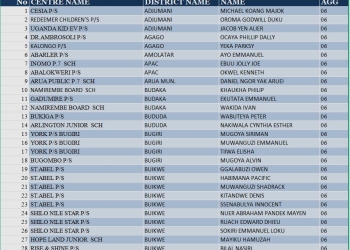
KAMPALA, Uganda— Uganda’s export earnings surged by 40.6% in March 2025, reaching $899.10 million (3.33 trillion Ugandan shillings), driven by strong performances in coffee, gold, fish and other key commodities. This marks one of the strongest year-on-year growth rates in recent years, up from $639.63 million (2.37 trillion shillings) recorded in March 2024.
According to the Ministry of Finance, Planning and Economic Development’s April Performance of the Economy Report, the growth was primarily fueled by increased export earnings from coffee, cocoa beans, gold, sugar, fish and maize.
Coffee exports saw the most significant increase, rising by 206.8% — or $133.89 million — from $64.74 million (239.54 billion shillings) in March 2024 to $198.62 million (734.89 billion shillings) in March 2025. This sharp rise was attributed to both an increase in global coffee prices and a boost in Uganda’s export volumes. Global coffee prices jumped from $3.27 per kilogram in March 2024 to $5.15 per kilogram in March 2025, largely due to unfavorable weather in Brazil and Vietnam, which raised fears of a global supply shortfall. Concurrently, Uganda’s coffee export volumes grew considerably, from 334,556 to 642,981 60kg bags, supported by improved robusta and arabica yields.
Cocoa beans also saw a significant rise, with exports increasing by 71.7% from $39.27 million (145.30 billion shillings) in March 2024 to $67.42 million (249.45 billion shillings) in March 2025.
Gold continued to be a pivotal driver of foreign exchange inflows, with export earnings climbing by 42.4% over the year, from $270.42 million (1 trillion shillings) to $385.08 million (1.42 trillion shillings). Fish and its products grew by 22.5%, from $9.82 million (36.33 billion shillings) to $12.04 million (44.75 billion shillings), while sugar exports rose by 31.2%, from $11.73 million (43.40 billion shillings) to $15.39 million (56.94 billion shillings).
Month-on-month, merchandise export performance grew by 7.3% from $838.18 million (3.10 trillion shillings) in February 2025 to $899.10 million (3.33 trillion shillings) in March 2025, primarily due to rising earnings from coffee, gold and maize.
Italy remained the top export destination for Ugandan coffee in March 2025, accounting for 38.43% of total coffee exports. Other major destinations included India (8.92%), Germany (6.89%), Spain (6.06%), and Sudan (5.72%). The Middle East remained Uganda’s leading overall export destination, contributing 37.1% of total merchandise exports, with the United Arab Emirates receiving 97.5% of those exports. The East African Community (EAC) ranked second at 20.1%, followed by the European Union (EU) at 18.7% and Asia at 16.9%. Within the EAC, DR Congo was the top importer of Ugandan goods, absorbing 43.3% of the region’s exports.
Uganda recorded trade surpluses in March 2025 with the Middle East ($186.30 million), EU ($117.70 million) and the rest of Europe ($0.18 million). Conversely, trade deficits were registered with Asia ($219.51 million), EAC ($152.97 million), and the rest of Africa ($146.02 million).
Apollo Munghinda, the principal communications officer at the finance ministry, stated that government interventions to promote exports were yielding results. “So much progress has been realised as the annual value of Uganda’s exports has exponentially grown from only $250m in the 1990s to currently $9b,” Munghinda said. He added that continued growth is expected through initiatives like the Investment for Industrial Transformation and Employment project, increased mining sector investment, agricultural production enhancements via the Parish Development Model, and increased funding for the Uganda Development Bank.
Maj. Gen. David Kasura Kyomukama, permanent secretary in the Ministry of Agriculture, Animal Industry and Fisheries, said coffee yield improvements were “partly linked to government-led strategic initiatives aimed at enhancing coffee production, including the distribution of improved seedlings, farmer training, and support for irrigation infrastructure.”
Geoffrey Kinaalwa Semakula, chief executive director of La’ Marc Coffee, noted that buyers’ increasing demand for traceable, ethically sourced coffee had opened new niche market opportunities. He stressed that exporters must now focus on branding and value addition beyond being raw bean suppliers.
Odrek Rwabwogo, head of the Presidential Advisory Committee on Exports and Industrial Development (PACEID), attributed the growth to strategic interventions, improved coordination across the export ecosystem, and rising global demand for Ugandan products. He said PACEID had enhanced Uganda’s visibility through market research and strategic use of local media.
Imports in March 2025 grew by 7.3% year-on-year to $1.11 billion (4.117 trillion shillings), largely due to higher project-related government imports and a rise in non-oil private sector imports, particularly mineral products, plastics, rubber, base metals, textiles, and prepared foodstuffs. On a monthly basis, the import bill increased by 25.4% from February 2025.
Asia remained the largest source of imports in March, contributing 33.3% of the total, with China (55.3%) and India (20.5%) being dominant partners within the region. Other significant import sources included the EAC (30.0%), the rest of Africa (16.3%), and the Middle East (13.2%). Within the EAC, Tanzania (57.9%) and Kenya (38.2%) were primary import sources.

















